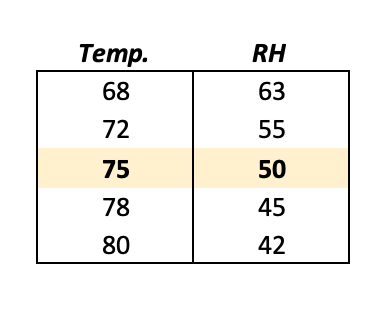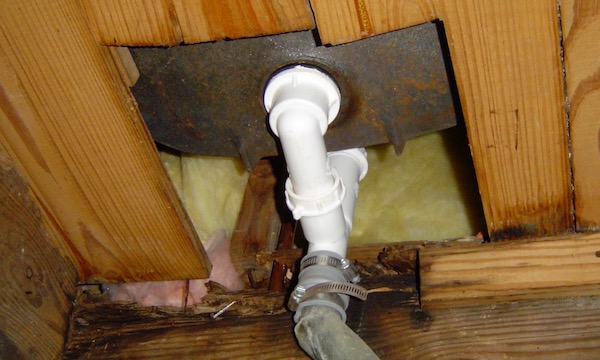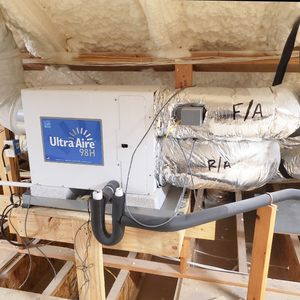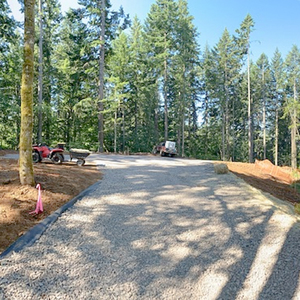
Back in the summer of 2005, I got a call to figure out a moisture problem in a new house. The homeowners took me into the master suite, where my eye was drawn immediately to the towel folded neatly on the floor. It hadn’t just fallen out of the laundry basket; it was there to catch the water dripping from the air conditioner supply vent directly above. Another towel was on the other side of the bed, and those two vents were dripping steadily. It didn’t take me long to find the problem.
Air conditioner vents get cold. Water vapor loves cold surfaces. Sometimes it leads to mold, as you can see in the photo above. Other times it leads to the paint coming off and rust forming on the vent. If you’re lucky, it’s just an occasional nuisance that doesn’t lead to long-term damage to the supply register, indoor air quality issues, or the need for towels on the floor. And if you’re really lucky, you wonder why I’m even writing about this because you’ve never seen it.
One cause, multiple reasons
There are a lot of reasons why this happens, but there’s only one cause. Let’s start with the simple one: the cause. Condensation occurs only when humid air is in contact with a cold surface. If your air conditioner supply vents are sweating, you have a cold surface (the vent) and near it you have air with water vapor in it. The threshold for condensation to occur is that the temperature of the cold surface has to be below the dew point of the water vapor in the nearby air.
That’s simple, right? Humid air with a dew point above the temperature of the supply vent causes condensation. Now, as for the reasons, we can start with the two big ones. Either the air is too humid (dew point too high) or the supply vent is too cold. That means the fixes are simply reducing the humidity of the air or raising the temperature of the vent, depending on which of the two reasons is causing the problem.
Dew point and the temperature of conditioned air
Is the dew point too high or the supply vent too cold? The special number here is 55°F. Well, it’s special if you keep your house at or close to the indoor design conditions recommended by the Air Conditioning Contractors of America (ACCA). Those conditions are 75°F for the indoor temperature and 50% relative humidity. Those conditions correspond to a dew point of 55°F, our special number.

If you don’t keep your house at 75°F and 50% relative humidity, the table above shows the relative humidity levels that correspond to a 55°F dew point when you go below or above a temperature of 75°F. As you can see, the colder you keep the house, the higher the relative humidity can be to keep your 55°F dew point. Conversely, if you keep the house warmer, you have to keep the relative humidity lower or the dew point will rise above 55°F.
But what if you’re not on or close to one of those lines leading to a 55°F dew point? The higher your relative humidity is, the higher the dew point is at a given temperature. That means you’re more likely to get condensation because the supply vent doesn’t have to be as cold. At a temperature of 75°F and relative humidity of 60%, for example, the dew point will be 60°F. A supply vent at a temperature of 60°F or below will sweat in that case.
If your indoor temperature and relative humidity are at or close to any of those rows in the table above, your dew point is about 55°F. That means as long as the vent itself is warmer than 55°F, you shouldn’t see any sweating. How cold is conditioned air? When it comes off the cooling coil, it’s usually about 55°F to 60°F. By the time it reaches the supply vent, it might be a bit warmer, depending on where the ducts are located and how well they’re insulated. Even if the air gets to the vent at 55°F, though, the vent itself is in contact with the warmer room and probably will be warmer than the air passing through it.
The starting point of figuring out whether your problem is humidity or supply vent temperature is to measure them. Getting the indoor air temperature and relative humidity isn’t hard, and once you have those you can easily find the dew point. The Dew Point Calculator website makes it easy with sliders for the three variables. Once you’ve determined whether humidity or vent temperature is the culprit, you’re in a position to eliminate the problem.
Why the indoor humidity might be too high
Here in the southeastern United States, the summer dew point is often above 70°F. The more of that high dew point outdoor air that gets into your house, the higher your indoor dew point will be. In some places, like condos on the beach, that outdoor humidity gets into the house because people open the doors and windows while the air conditioner is running. Easy fix: Close the doors and windows.
More likely, the house stays too humid because of unintentional infiltration. Most houses are too leaky. The fix is air sealing. Get a blower door test, seal up as many leakage sites as possible, and the indoor humidity will go down in summer. A house above a vented crawl space is connected to a big source of humidity, especially when it has holes as large as the bathtub drain hole shown below. Encapsulate and condition the crawl space or make the floor above the crawl space airtight.

One way that outdoor air gets inside intentionally is through ventilation. When you turn on a bath fan or a range hood, you exhaust indoor air and cause outdoor air to come in. Clothes dryers do this, too.
If the house doesn’t have a lot of infiltration and isn’t over-ventilated, look for indoor sources of humidity. Some possibilities are:
- Showering without running the bath fan
- Doing a lot of cooking
- Having a lot of aquariums (You know who you are, afishionados!)
- Steam showers, hot tubs, indoor pools, water features
Two more humidity trends are working against you, too. New houses keep getting more insulation and air sealing, which reduces the cooling load so air conditioners don’t run as much. Also, some of the more advanced air conditioning systems have less ability to remove moisture. In some cases, the only way you can get the humidity low enough to prevent the vents from sweating is to use a dehumidifier.
That humidity’s got to be coming from somewhere. Your two fixes here are to reduce the source of the humidity or use a dehumidifier.
Why the supply vent might be too cold
If the indoor humidity is OK, the AC vents still can sweat if they get too cold. The two main causes of excessively cold vents are low refrigerant level and low air flow through the system. You’ll need an HVAC company to check the refrigerant level, but you may be able to do something about low air flow. Here are some of the main causes of low air flow:
- Dirty filter
- Excessively restrictive filter
- Return or supply vents blocked by furniture, rugs, or other items
- Dirty cooling coil
- Excessively restrictive duct system
You’ll probably need to hire a pro for the last two, but if you suspect low air flow, the first thing to do is check the filter. Then check to see if all the vents are unblocked and the louvers open.
I’ve also heard of cases where the air flow was too low in multi-stage or variable capacity air conditioners operating at low speed. Ideally, the refrigerant and air flow change together in just the right amounts, but complex systems don’t always do what you want them to do. Sometimes the air flow is fine at one speed but too low at another speed. In addition, multi-stage or variable capacity air conditioners are designed to give you long runtimes. If cold air is always blowing out of the vents in a house that’s on the edge of having sweating vents, that might be just enough to get those vents wet.
Start with the basics
The cause of sweating vents is simple. Air that’s humid enough finds a surface cold enough. When vents start beading up with water—or worse, dripping—either the humidity is too high or the vent is too cold. It’s not hard to figure out which of those two is the culprit. Just find the dew point of your indoor air. If it’s close to 55°F, the problem lies with the vents being too cold. If it’s several degrees above 55°F, the problem may be the indoor humidity. From there, you can sort through the potential sources of humidity or low air flow to see if you can fix the problem yourself. Otherwise, call in an HVAC pro to find the problem and stop those vents from sweating.
Oh, you’re probably wondering about that house with the dripping supply vents in the master suite. Turns out it had a problem with humidity, not supply vent temperature. They had spray foam insulation installed beneath the roof deck to encapsulate the attic and make it part of the conditioned space. But the spray foam contractor missed part of the eave, so it wasn’t sealed well.
To make matters worse, the master bedroom had a tray ceiling with a gap all the way around, connecting the bedroom to what should have been a sealed attic. Negative pressure in the attic from duct leakage and in the master bathroom when the exhaust fan ran pulled in humid Georgia air, and it didn’t mind the gap. It got into the bedroom through that tray ceiling gap, finding those nice, cold air conditioning vents. The spray foam contractor sealed the eaves, and the problem went away.
-Allison Bailes of Atlanta, Georgia, is a speaker, writer, building science consultant, and founder of Energy Vanguard. He is also the author of the Energy Vanguard Blog. You can follow him on Twitter at @EnergyVanguard. Photos and illustrations courtesy of the author.
Weekly Newsletter
Get building science and energy efficiency advice, plus special offers, in your inbox.















6 Comments
I agree with "too cold or too humid" and reduce moisture sources. But you can't completely fix indoor humidity with less moisture or proper AC airflow (CFM/ton) - you need a dehumidifier.
> air flow was too low in multi-stage or variable ... at low speed
In most cases, it's the opposite. The fan doesn't go low enough to match the compressor and the unit stops dehumidifying. Terrible for comfort, but the high CFM/ton does reduce sweating. Perhaps this is why they design in this flaw.
Duct temp can be reduced by mixing in additional air (bypassing the coil). You want about 300 CFM/ton flowing across the coil and 500 CFM/ton flowing through the ducts.
Unfortunately, AC manufacturers don't make this effective fix simple.
Jon R, yes, I absentmindedly forgot about the necessity of a dehumidifier in some cases when I first wrote the article. I added it this morning to this post in the Energy Vanguard Blog and have now added it here. Thanks.
Is it really that the fan doesn't go low enough to match the compressor or that in variable capacity systems, the compressor cycles on and off while the fan keeps running on low? That's my understanding. The fan going lower than the compressor applies mainly to multi-stage equipment, I believe. I was just talking to a contractor about that this week, but I'll check around some more.
In many/most inverter units, the specs indicate that the fan has a limited range (eg 2:1) and the compressor has much more (eg 5:1). And indeed, low-load measured SHR goes to approximately 1 (when you want it to be much less). This is a comfort issue that didn't occur with single speed (auto fan mode) units, even when over-sized.
https://www.nrel.gov/docs/fy11osti/52175.pdf
Thanks for pointing that out. I wasn't aware of that problem. It's unfortunate, given that making a fan work over a wider speed range isn't a technical challenge. Seems like it was just a poor design decision.
It's too common not to be purposeful, but not clear to me why. Just to pump the efficiency numbers? To reduce complaints about condensation? IMO, It's a failure of the rating system, encouraging manufactures to produce low comfort in humid climates.
Summary - check CFM/ton at low (say 1/3) load - the AC unit is going to spend a lot of time operating at this point and if it doesn't dehumidify well (say < 350 CFM/ton), the less energy efficient dehumidifier is going to have to make up the difference.
> IMO, It's a failure of the rating system, encouraging manufactures to produce low comfort in humid climates.
I think that's exactly it. Meanwhile, occupants simply lower the setpoint to compensate.
Tangent: I've been trying to figure out a metric to evaluate A/C energy performance that includes latent load. I've started looking at kWh per CDD * DPDD (dew point degree days, base 55º) as a starting point for my own house and am not sure it's telling me much from a quick analysis. (The AHU has a dehumidifier mode, so indoor DP is nearly constant.) Is there some industry standard metric that I haven't run across?
Log in or create an account to post a comment.
Sign up Log in